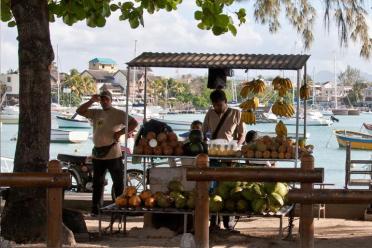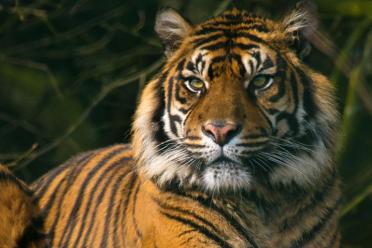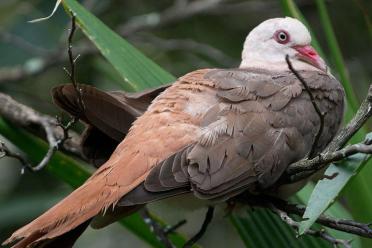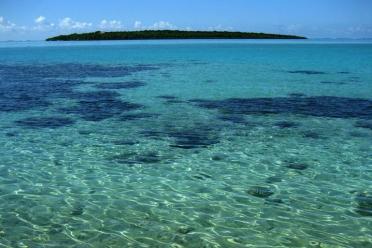The Pink Pigeon: on and off the brink of extinction
Science and conservation come together to save this remarkable bird from extinction.
Two thousand kilometres off the South-East coast of Africa lies a special island. Special not because of its white sandy beaches and gently rolling waves, nor the vibrant coastal city that stands as its human capital. Not even the tropical forests and gleaming waterfalls.
This island is Mauritius, where the legendary dodo lived and died – the last one on Earth seen in 1662.
Such is the fate of many species that encounter mankind, even more so in isolated places like Mauritius, where many of the species living on the island live only there. Nowhere else in the world will you find the Mauritius Kestrel or the Lesser Night Gecko. There are several bird species at threat of extinction on the island, clinging to survival in the remaining forest and in captivity – such as the Mauritius Pink Pigeon.

And it is to this unassuming, mostly unknown bird that we shall turn. Most city folk across the world associate pigeons with nuisance. Harassing passers-by for scraps of food, legally a pest in many countries and frequently targeted for cruelty, pigeons generally have a bad reputation.
But look at the heroic efforts of pigeons during the great wars of the twentieth century; saving many lives by carrying important messages across the battlefields. These birds were literally decorated war veterans. One of them even survived a wartime plane crash before flying home, severely injured.

These remarkable birds are often forgotten among the more well-known, endangered and vulnerable species. Which species can you think of right now? Perhaps the black rhino? Or Sumatran rhino? Or the Sumatran tiger? Or most of anything from Sumatra, for that matter. How about the polar bear, or giant panda?
If I were a betting man, I would wager that most people have never heard of the pink pigeon. But why raise its profile, anyway? Surely efforts are better focused on other, iconic species. Those that sell more zoo tickets, maybe? Or more adoption packs on the internet. How do you even decide which vulnerable animals to support in the first place?
To answer this, we need to dive into the history of the pink pigeon and the cutting-edge science used to help keep it on this side of extinction.


Increasing the numbers of this endangered species at first appears to be a great success, but this doesn’t paint the whole picture.

In 1991 there were less than 12 of these birds in the world.
They were classified as ‘critically endangered’. This means they were at immediate threat of extinction. The only classification which is more serious is ‘extinct in the wild‘, meaning the remaining animals of a species can only be found in captivity.
There were so few pink pigeons left that an outbreak of disease might have killed them all in a matter of days. The pink pigeon got within a hair’s breadth of following its relative, the dodo, into extinction.

Even with many individuals, the species could still struggle to adapt if the overall gene pool is just not varied enough.

Luckily, there are those among us who stepped up to the challenge of saving it.
Scientists and conservation groups, such as Prof Carl Jones MBE at the Durrell Wildlife Conservation Trust and the Mauritian Wildlife Foundation have worked closely together over decades to bring the number of pink pigeons up to around 400, which is roughly how many we have alive today.
But this isn’t the whole story…
When we look at the genes of the pink pigeons, we find that they are very similar across all the remaining birds – their genetic diversity is really low. This is not a good thing.
Why?
Because it means that there aren’t enough differences in the pink pigeon gene pool for the population to adapt to changes in their environment.
Say there is an increase in fast-moving predators, such as cats, which want to eat the pigeons. We would expect the slowest pigeons to be caught and the fastest ones to get away, on average. Because the slow ones get eaten, they don’t get the chance to breed and pass on their ‘slow’ genes. The fast ones, you might be guessing, do survive – and go on to produce offspring. They consequently pass on their ‘fast’ genes and the population becomes almost entirely ‘fast’ individuals.
This example shows how a species adapts to its environment. If it doesn’t, it will struggle to survive and likely go extinct. The reason this adaptation could happen is because there were enough different genes in the gene pool to allow the best ones to be selected. In other words, there is more ‘stuff’ (the genes) for evolution to work with.
Unfortunately, the pink pigeons’ gene pool has low variation and, therefore, the species has weak ability to adapt to any changes in its environment.

Biologists refer to ‘effective population size,’ a metric that reflects how varied the gene pool is, combined with how fully the variation is passed on to the next generation.
If you have a population size of 5000, say, but a gene pool that has very little variation in it, then you can say that the effective population size is actually much smaller than the 5000 individuals. That’s simple to grasp.
But there are is also the limit of how many mating partners each pigeon may have, and how many eggs it can sire in its lifetime. Saving genetic variation comes down to chance. The laws of chance will relegate some of the rare gene variants to oblivion, regardless of their value. The frequency of good and bad genes will ‘drift’ in breeding populations because of chance – particularly when the effective population size is small.
This is exactly what has happened, and is still happening, with the pink pigeon.
There are around 40 birds living in a conservation area on Mauritius called the Ile Aux Aigrettes (IAA), but because this population has very low genetic diversity, its effective population size is actually around eight!
This effective population size is extremely worrying, and likely to lead to the pink pigeon’s extinction.
The key is that just increasing the number of birds doesn’t always result in its long-term survival.

Some of the key threats manifest as deforestation, invasive species, disease and severe storms.
Mankind has reduced the Mauritian forest to just two per cent of its fifteenth century extent. We also brought rats over to Mauritius on our boats, and theft of pigeon eggs from their nests by rats could have easily snuffed them out. Then we decided it would be a good idea to introduce cats to reduce the rat problem, but fledgling pigeons are an easier hunting target than young rats …
Needless to say, introduced species don’t often rank highly on the list of great ideas.
So what can be done?
There are around 400 birds in total left in the wild. That sounds like they are safe, but as we’ve discussed, they are effectively still in the ‘critically endangered’ category. Ironically, if they could be officially re-classified as critically endangered, that would actually help to fund and motivate conservation and captive breeding efforts.
If you’re curious, their numbers would have to drop to around 50 before they get re-classified, which should tell you exactly why the effective population size being below that figure is so worrying!
Given that its taken almost 20 years to get the pink pigeon back on its feet – from 12 to around 400 birds – any slide backwards would be disastrous. The sad fact is that only about six per cent of squabs (young pigeons) survive to adulthood.
So what does the science say we should do?
The ideal solution is to use genetics to identify the ‘best’ parent individuals across all the isolated subpopulations – whether in zoos, reserves or the Mauritian forest – and help them breed, to safeguard their diversity as much as possible. Conservation biologists could also identify and select parents with resistance to Trichomonas infection – Trichomonosis is an epidemic disease, identified as a primary cause of mortality in pink pigeon squabs (Swinnerton et al. 2005) and in 52% of freshly recovered pink pigeon corpses (Bunbury et al 2008).
So it really does look as though science can help even if the pink pigeons’ plight looks desperate.
If you want to know more about the conservation work helping to keep the Pink Pigeon population alive and well, visit the Durrell Wildlife Conservation Trust website. Our own researchers at EI, the Clark Group, are busy working on the pink pigeon genome – there’s plenty of work still to do – and hopefully new insights can be fed back into the conservation work to keep this amazing bird alive.
Further Reading
More on genetic drift.
More on effective population size.
Credits:
Much of the research cited here was conducted as part of Mohammed Albeshr’s PhD work, funded by the Saudi Cultural Embassy and his home King Saud University.
Mohammed was co-supervised by Diana Bell, University of East Anglia, Cock van Oosterhout (ENV), Kevin Tyler (MED) with expert support across laboratory work, data manipulation and analysis by Lawrence Percival-Alwyn of the Clark Group at EI. The pink pigeon samples were collected in collaboration with the Mauritian Wildlife Foundation and the government National Parks Conservation Service.
We would like to thank the Durrell Wildlife Conservation Trust for their support and comments.